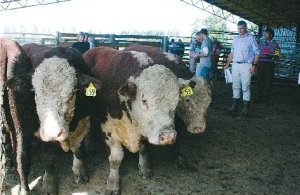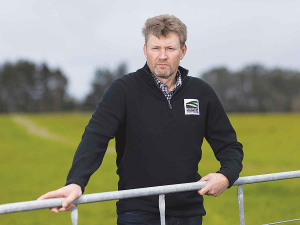That was graphically illustrated in the closing session of one of the first of a series of workshops Beef + Lamb New Zealand is running – 'Better Bull Buying Decisions'.
Following a mock helmsman auction featuring a selection of real life Orari Gorge Hereford Stud bulls, teams' returns on their genetic investment differed by over $100/calf.
While presenter Andrew Byrne of Southern Beef Technology Services, Australia, stressed that his quick financial analysis of the auction result was crude, owing to the time constraints, it made the point.
"We need to balance the genetic value with the price paid. The key thing, as a commercial producer, is getting best value for money."
In the mock auction some teams put their entire $12,000 budget on what they believed to be the best bull for the scenario given: a self-replacing breeding herd producing 330kg carcase-weight finished steers for export at about 20 months old with 10mm of fat.
Others split their money $9000 and $3000, buying a back-up bull at the sale minimum, while some chose not to chase the absolute best bulls on figures and appearance because they'd been outbid, but instead bought close seconds for $3000 instead.
A team deploying that latter strategy achieved the best return from their purchase, assuming it sired 60 calves/season for four years.
"These bulls at $3000 were really good value for money," pointed out Byrne, as he presented his quick analysis showing the winning team's bull would, over those four years, add a net $17,940/year, or $299/calf. Meanwhile the lowest of the eight teams on the day would have cleared $189/calf, having blown their entire budget on one bull.
Before Byrne revealed his analysis the teams relayed their reasoning for buying the bulls they did, talking about scores for various traits and appearance of the animals. Not one mentioned monetary value of the genetics, despite the scenario presented closely matching that which the export/maternal index for Herefords – presented as a dollar figure – is designed for.
Byrne, who's run similar programmes across Australia, says that's typical.
"They definitely should be valuing their genetics," he told Rural News after the day.
"They need to pay attention to what cost those genetics come at."
Such calculations can and should be done in the calm of the farm office or home prior to going to a bull sale, as should a study of the EBVs, he stresses.
Having found a breeder whose principles and objectives align with yours, go through the sale catalogue using the index most closely matched to your production system to rank sires, then check the EBVs to eliminate any which don't meet your minimum requirements for certain traits, such as birthweight, calving ease or mature cow weight.
"Making a visual assessment first then going to the EBVs would be fine if you had unlimited time [at a sale] but you don't."
Online tools can help rank sires from one or more studs, allowing users to search and sort data by entering acceptable ranges for any number of traits, he points out. "All the breed societies offer an online version of the [Breedplan] database."
Online data is also the latest available, as opposed to what was available when the sale catalogue went to print, and is complete. "When you look at a paper catalogue, a lot of people don't give the full data set, just for space requirements."
Having crunched the numbers, Byrne says check fertility, genetic condition, temperament and pedigree information, and only then make a visual appraisal.
Checking pedigree is wise even for commercial producers to avoid inadvertent inbreeding by buying bulls from the same bloodline year in, year out, he points out.
BLNZ Central South Island extension manager Aaron Meikle says the workshops are targeted at agents as much as farmers, given the key role agents play in many farms' buying decisions.
"A lot still buy bulls for clients, much more than is the case with rams these days."
But whoever does the buying, the overall objective is the same, he stresses. "More efficient use of the money they spend, or invest, in bulls... We want to prove this stuff works and make sure farmers get a return on the money they're spending on genetics.
"Farmers don't necessarily need to understand exactly how the EBVs work as long as they are confident they do and put pressure on their breeders to be using it."
Meikle re-iterated that in his summing up of the day, saying there are "two key things" Beef + Lamb wants people to take from the workshops: "That these systems work, but also that it's not the b-all and end-all. You still need that visual assessment."

















